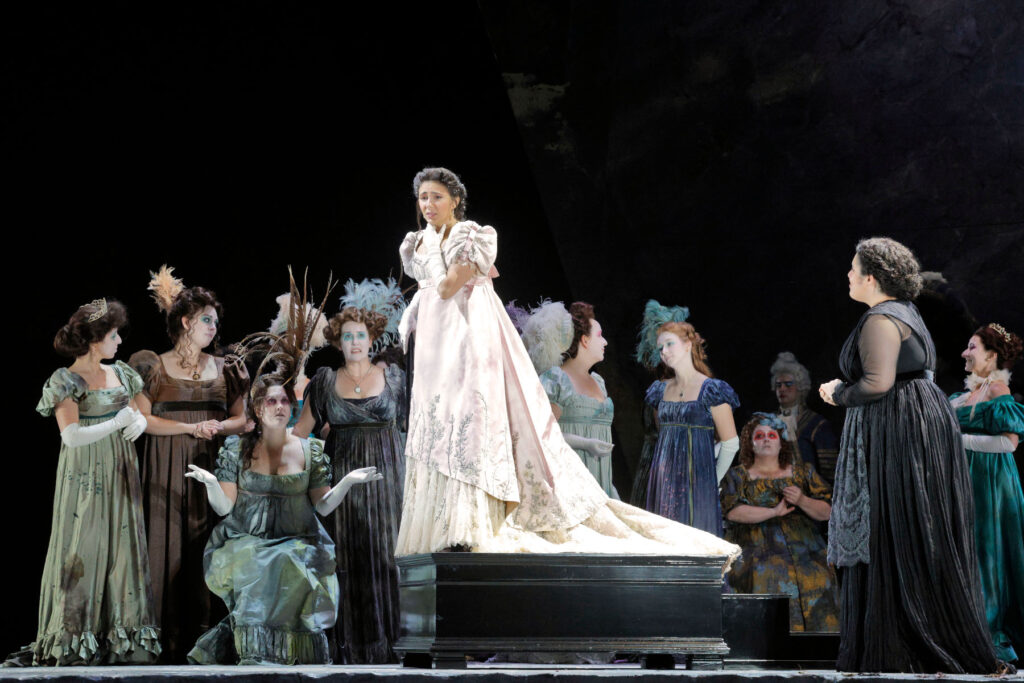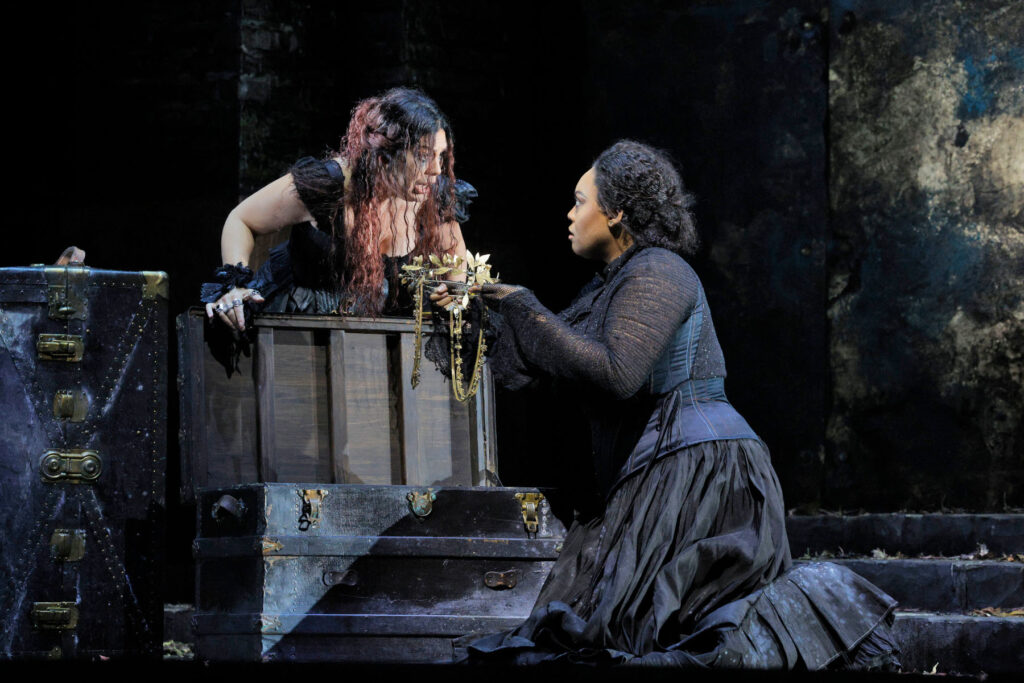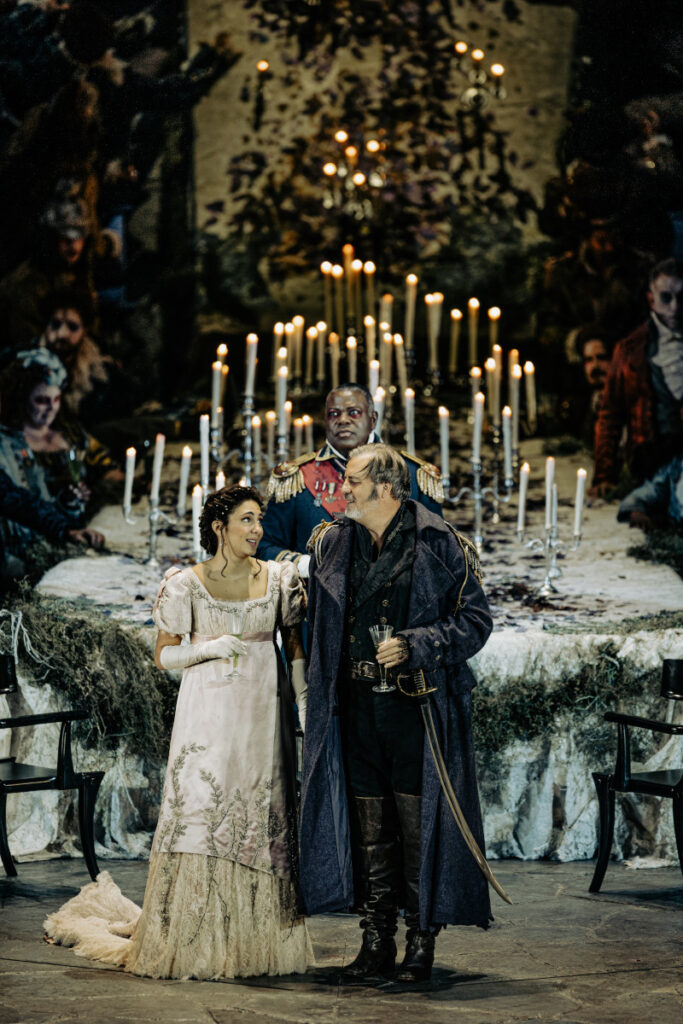The Lyric Opera of Chicago opened its 2025-2026 season recently with a dramatically powerful production of Luigi Cherubini’s Medea. The opera is a co-production of Lyric Opera of Chicago, the Metropolitan Opera, New York, the Greek National Opera, and Canadian Opera Company. The title role is portrayed by Sondra Radvanovsky. Medea’s former lover Giasone and father of both sons is Matthew Polenzani. Creonte, King of Corinth is sung by Alfred Walker. Elena Villalón sings the part of Glauce, daughter of Creonte and betrothed of Giasone. Zoie Reames sings the part of Neris, confidante and attendant of Medea. The first and second handmaids are Emily Richter and Camille Robles, and Captain of the Guard is Christipher Humbert, Jr. The production is directed and with set designs by Sir David McVicar. Costume designs are by Doey Lüthi, and the original and revival lighting designers are Paule Constable and Clare O’Donoghue respectively. The prompter is Susan Hult Miller. The Lyric Opera Orchestra is conducted by Enrique Mazzola and the Lyric Opera Chorus is prepared by Michael Black. In these performances debuts at Lyric Opera of Chicago are made by Mmes. Villalón, Lüthi, and O’Donoghue.
An effective bridge between Classical tragedy and Cherubini’s Neo-Classical treatment is realized in the present production. Hints of ancient, architectural models emerge from elements such as weathered, stone steps and the indication of a temple. At the same time, military uniforms reminiscent of Napoleanic forces suggest the late eighteenth-century period of the opera’s composition. A façade of mirrors through which the chorus moves and by which the action on stage seems magnified recalls interior designs from the later time.

The overture is taken, at first with noticeably brisk tempos, then settling into a measured, taut performance for its duration, such that instrumental sections contribute to the dramatic sweep of the forthcoming emotional conflicts. During the balance of the overture an open eye depicted on a suspended drape hangs over the stage, receding from view only toward the orchestral finale. The omniscient, mythological force, coupled with Medea’s quest for resumption or vengeance, lingers in the perception of the viewer through the medium of the eye.
Despite her entrance only part-way through the opening act, Medea’s spirit hovers aloft and inhabits the thoughts of the remaining characters. The first scene depicts the contrast of emotions looming in the impending union of Glauce and Giasone. Both the attendants of Glauce and the chorus comment on the unfortunate entry of sadness into what should be a celebration of love. In her extended aria, “O Amore, vieni a me,” Ms. Villalón’s flexible lyricism captures the attractive melodies defining Glauce’s natural innocence; yet rather than fear of Medea’s wrath, Villalón’s approach communicates an apprehension lighter in emotional weight than the scene might indicate.

Mr. Walker’s Creonte sings with declarative force and noble demeanor of his faith in divine help for the future bliss of his daughter. Mr. Polenzani portrays Giasone, at first, as a sympathetic figure longing to forget the past now that he has arrived at a court of welcome asylum. His voice reflects touchingly on the sadness detected in his future spouse. Ironically, the “Argonauti” are called by Polenzani with an emphatic pitch to assist by displaying the golden fleece to Glauce. The instinctive, negative reaction of Glauce calls up the association of the precious fleece not with treasure but rather with Medea, who had assisted Giasone in gaining its control. In this staging the fleece is hanging suspended as a diaphanous veil studded with glittering golden highlights.
Medea’s entrance as a veiled stranger and her subsequent interaction with Giasone introduces now on stage the central conflict of the opera. Ms. Radvanovsky invests the role with both vocal and dramatic distinction. Her musing on the past can be tender, yet thoughts of betrayal and abandon sound gravelly in resentful delivery. Radvanovsky’s top pitches are shaded, at times, with vibrato as a means of individual interpretation, while her emotional pleading shows an estimable command of vocal range. Both she and Polenzani achieve exciting heights as Giasone refuses to consider his previous liaison with Medea.

It can be argued that Act Two is the crux of Cherubini’s opera. All three temporal dimensions are reflected in characters’ thoughts and actions. Creonte allows Medea one day more in Corinth; Giasone concedes in permitting Medea access to their sons; and, the wedding celebration of Glauce and Giasone concludes the act. In the midst of such external arrangements the character Neris is introduced with multiple functions. She assists Medea as confidante and also comments on their faithful relationship, while she reveals her perspective on the fate of her mistress. As Neris Ms. Reames shows sensitivity to the text as well as a sympathetic understanding of the character of Medea. In the extended aria, “Solo un pianto con te versare,” Reames sings with careful phrasing while her voice dips into contralto range, then rises to expressive top notes. This expressive outpour ring delineates not only her bond with Medea but also her desire for others to understand the plight of her mistress.
The scene between Giasone and Medea is presented by the two principal singers as a reminder of their previous union. The present wedding celebration rallies Medea’s resolve to focus on thoughts exclusively of revenge. Much of Act Three details the attempts of Neris to mollify the violent reactions and plans of Medea These scenes culminate in Neris called upon to bring the children to Medea while begging her mistress to spare their lives. Radvanovsky emerges at the close, stained with blood, as the dominant vocal and dramatic figure whose final acts remind all of her power.
Salvatore Calomino
Medea
Music by Luigi Cherubini
Libretto by François-Benoît Hoffman | Italian translation by Carlo Zangarini
Based on Euripides’s Medea and Pierre Corneille’s play Médée
Click here for this production’s program.
Top image: Sondra Radvanovsky.
All photos © Cory Weaver unless otherwise indicated.